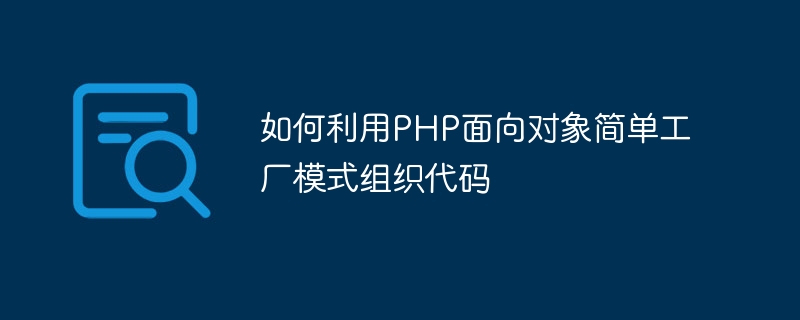

How to use PHP object-oriented simple factory pattern to organize code
Introduction: In PHP development, code organization is a very important part. Using object-oriented programming (OOP) design patterns can help us better organize and manage code. This article will introduce a common design pattern-Simple Factory Pattern, and demonstrate how to use this pattern to organize code through PHP sample code.
1. What is the simple factory pattern?
The simple factory pattern is a creational design pattern that provides an interface to create objects, but which object is specifically created is determined by the factory class, not directly created by the caller. The core idea of the simple factory pattern is to encapsulate the object creation process. The client only needs to know what objects are needed, but does not need to know the details of object creation.
2. Code example of simple factory mode
In this example, we simulate an electronic device type factory, which can produce corresponding device objects according to different device types passed by the client. .
Step 1: Create device interface and specific device class
First, we need to create a device interface Device and define the functional methods of the device in the interface.
interface Device
{
public function turnOn();
public function turnOff();
}Then, according to different types of devices, we create specific device classes and implement the methods in the device interface.
class Laptop implements Device
{
public function turnOn()
{
echo "Laptop is turning on...
";
}
public function turnOff()
{
echo "Laptop is turning off...
";
}
}
class Smartphone implements Device
{
public function turnOn()
{
echo "Smartphone is turning on...
";
}
public function turnOff()
{
echo "Smartphone is turning off...
";
}
}Step 2: Create a device factory class
Next, we create a device factory class DeviceFactory, which creates the corresponding device object based on the device type parameters passed by the client.
class DeviceFactory
{
public static function createDevice($type)
{
switch ($type) {
case 'laptop':
return new Laptop();
case 'smartphone':
return new Smartphone();
default:
throw new Exception("Invalid device type: {$type}");
}
}
}Step 3: Test code
Finally, we use the device factory class to create the device object in the test code and call the device's functional method.
// 创建一个笔记本电脑对象
$laptop = DeviceFactory::createDevice('laptop');
$laptop->turnOn();
$laptop->turnOff();
// 创建一个智能手机对象
$smartphone = DeviceFactory::createDevice('smartphone');
$smartphone->turnOn();
$smartphone->turnOff();Run the above test code and the following results will be output:
Laptop is turning on...
Laptop is turning off...
Smartphone is turning on...
Smartphone is turning off...
At this point, we successfully used the simple factory pattern to organize the code, encapsulating the device creation process in the device factory class, and the client only needs to call the factory class interface methods without caring about the details of object creation.
3. Summary
In project development, it is crucial to organize and manage code reasonably. Object-oriented design patterns can help us improve the flexibility, maintainability and scalability of our code. The simple factory pattern is a common design pattern that can help us encapsulate the object creation process, making the code clearer, easier to maintain and expand.
Through the above examples, we learned how to use the PHP object-oriented simple factory pattern to organize code. I hope readers can apply this design pattern to actual development to better organize and manage their own PHP code.
The above is the detailed content of How to organize code using PHP object-oriented simple factory pattern. For more information, please follow other related articles on the PHP Chinese website!